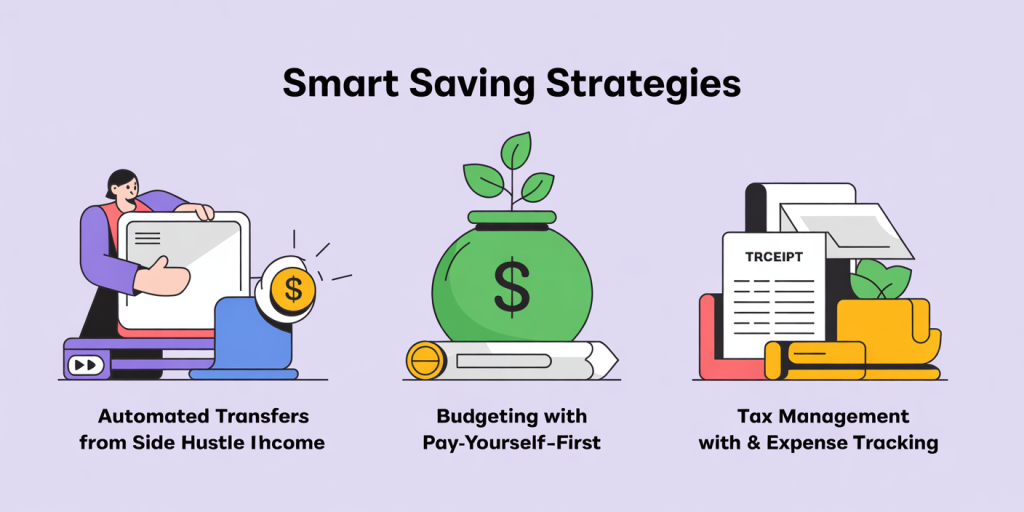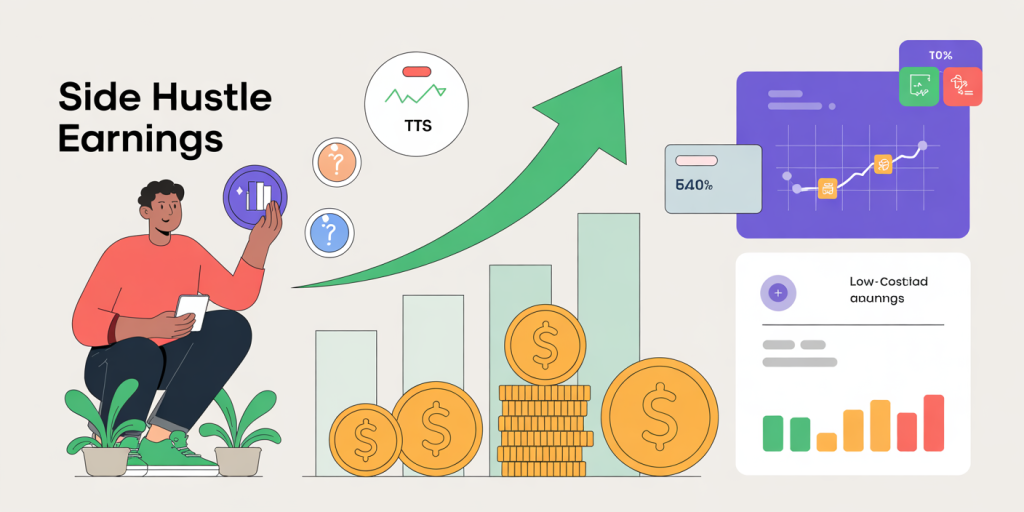Side Hustles and Saving: How to Maximize Your Extra Income
In today’s economic landscape, relying solely on a primary salary often isn’t sufficient to achieve financial stability or reach long-term financial goals. The rising cost of living, inflation, and fluctuating job markets have led many individuals to explore side hustles as an essential source of supplemental income. Beyond just earning, the strategic management of this extra income through saving and investment is crucial for financial growth and security. This article delves into effective ways to maximize your side hustle earnings and save efficiently to build wealth over time.

The Growing Trend of Side Hustles in the Modern Economy
Side hustles—part-time gigs or freelance work done in addition to a full-time job—have surged in popularity across various demographics. According to a 2023 survey by Bankrate, nearly 48% of American workers report having some form of side income, a significant increase from 38% just five years ago. This trend is primarily driven by the need to cover daily expenses, pay off debt, or save for bigger financial goals such as buying a home or retirement.
The gig economy’s expansion has facilitated numerous opportunities, including ride-sharing, freelance writing, or selling handmade products online. These ventures allow people to tap into their skills and passions while enabling more control over their income streams. However, the challenge lies not in earning extra money but in allocating and saving this income wisely, ensuring that hard work translates into tangible financial progress.

Selecting the Right Side Hustle to Maximize Earnings
Choosing the right side hustle depends on several factors such as skills, available time, market demand, and startup costs. Research reveals that side hustlers who align their gigs with existing skills tend to make more money and sustain their efforts longer. For example, a software developer offering freelance coding services can command higher rates compared to someone picking up random tasks without specialized skills.
Comparative Table: Popular Side Hustles by Average Earnings (2023)
| Side Hustle | Average Hourly Rate | Startup Costs | Flexibility | Skill Level Required |
|---|---|---|---|---|
| Freelance Writing | $25 – $50 | Low | High | Medium |
| Ride-Sharing Driver | $15 – $30 | Medium (car) | High | Low |
| Online Tutoring | $20 – $45 | Low | Medium | High |
| Handmade Crafts Seller | $10 – $40 | Low-Medium | Medium | Medium |
| Social Media Management | $20 – $60 | Low | Medium-High | High |
For example, Jane, a marketing professional, started offering social media management services on the side. She leveraged her expertise to raise rates over time, growing a steady client base and earning an additional $3,000 monthly. This extra income enabled her to increase her emergency fund and accelerate her mortgage payments.
Strategies to Save and Optimize Side Hustle Income
Earning extra income alone is not enough to improve financial health unless accompanied by disciplined saving and smart money management. Many side hustlers overlook this critical step, leading to the pitfall of increased spending instead of growth in savings.
One practical method is automating savings. Setting up a separate savings account specifically for side hustle earnings and automating transfers immediately after payment deposits can prevent spending temptations. According to a 2022 report by Deloitte, automated savings reduce the likelihood of impulsive spending by up to 40%.
Another approach is budgeting with a “pay-yourself-first” mindset. This means allocating a certain percentage—suggested 30-50%—of your side hustle revenue directly into savings or investment accounts before using the rest for discretionary expenses. For example, Mark dedicates 40% of his Uber driving income to his retirement fund. In three years, this consistent saving habit contributed over $15,000, including interest and investment growth.

Leveraging Tax Benefits and Managing Expenses
Side hustles often come with tax implications, and improper management can lead to greater liabilities, reducing your net savings. Understanding tax deductions related to side businesses is essential. According to the IRS, common deductible expenses include home office costs, supplies, business-related travel, and internet services.
An illustrative case is Lisa, a freelance graphic designer, who carefully tracks all business purchases and allocates 20% of her gross side income towards quarterly estimated taxes. This preparation prevents end-of-year surprises and maximizes deductions, enhancing her effective savings rate.
Additionally, controlling expenses associated with side hustles is another vital tactic. High operational costs can neutralize extra earnings. For instance, ride-share drivers should balance vehicle maintenance expenses and fuel costs against their gross income. Utilizing apps that monitor mileage and fuel efficiency can optimize profit margins. Drivers who switch to more fuel-efficient cars report an average 15% increase in net income after costs, per a 2023 Consumer Reports study.
Investing Your Side Hustle Earnings for Long-Term Growth
Saving is just the first step; investing the saved income can significantly accelerate wealth accumulation. With side hustle profits often forming irregular cash flows, choosing flexible and low-cost investment vehicles is advisable.
Index funds and exchange-traded funds (ETFs) are ideal options for beginner investors due to their diversification and low fees. For example, Emma, who earns $600 monthly through freelance writing, directs 50% of her side hustle income to a retirement account invested primarily in ETFs. Over five years, she saw a compound annual growth rate (CAGR) of around 7%, consistent with market averages.
For more aggressive growth, some side hustlers consider peer-to-peer lending platforms or real estate crowdfunding, offering higher returns but accompanied by higher risks. These alternatives are suitable for those who have already built an emergency fund and possess some investment experience.
Comparative Table: Investment Options for Side Hustle Savings
| Investment Type | Average Annual Return | Risk Level | Liquidity | Minimum Investment |
|---|---|---|---|---|
| Index Funds / ETFs | 6-8% | Low to Medium | High | $100-$500 |
| Peer-to-Peer Lending | 8-12% | Medium to High | Medium | $500 |
| Real Estate Crowdfunding | 8-15% | Medium to High | Low to Medium | $1,000 |
| High-Yield Savings | 2-4% | Very Low | High | $0 |
Investing small, consistent amounts from your side hustle can lead to impressive growth in your net worth over time without overwhelming your primary budget.
Future Perspectives: The Evolving Landscape of Side Hustles and Savings
The future of side hustling is increasingly intertwined with technological advancements and changing workforce dynamics. Artificial intelligence and automation tools are opening new avenues for micro-entrepreneurs to scale their side businesses efficiently. For example, digital marketing consultants now utilize AI-driven analytics to optimize their campaigns, reducing labor hours while increasing client satisfaction.
Another emerging trend is the increased emphasis on financial literacy and digital banking innovations that make saving and investing more accessible. Robo-advisors offer customized investment portfolios based on side hustle earnings, allowing users to manage their finances effortlessly through smartphone apps.
In addition, legislation changes in various countries are shaping the regulatory landscape for gig workers, including benefits and tax reforms, making it essential for side hustlers to stay informed and adapt their strategies accordingly.
The intertwining of side hustles with smart saving and investment strategies is not just a short-term solution but a robust framework for financial independence and security. By leveraging skills effectively, managing expenses, optimizing tax benefits, and investing carefully, side hustlers can transform their extra income into a powerful vehicle for long-term wealth creation.
—
This comprehensive overview offers practical pathways and data-driven insights to maximize your side hustle earnings and savings. As this sector evolves, individuals who adopt disciplined and informed approaches will be best positioned to capitalize on the opportunities presented by the modern gig economy.
